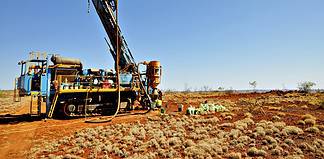AS the largest single deposit of uranium in the world, and one of its most significant deposits of copper, gold and silver, BHP’s Olympic Dam is one of the globe’s premier poly metals mines.
The underground mine consists of about 450km of underground roads and tunnels, and ore is transported via a fully-automated subterranean rail network to the crushing, storing and ore hoisting facilities.
The mine has a fully integrated ore to metal processing facility that utilises two grinding circuits used to extract high quality copper concentrate from sulphide ore through a flotation extraction process.
Olympic Dam’s metallurgical complex includes a grinding and concentrating circuit, a hydrometallurgical plant that uses solvent extraction circuits for copper and uranium, a copper smelter, a copper refinery and a recovery circuit for precious metals.
2018
2018 was a year of mixed results for the mine. BHP undertook the single largest shutdown in the mine’s history, which started in August 2017 and was carried out over 100 days.
The major upgrade of the smelter that begun in August 2017 was followed up by more major upgrade work to the refinery, the concentrator and site technology.
This lowered the mine’s 2018 copper guidance by 18pc to 135kt, and slowed the ramp-up of operations after the smelter upgrade had been completed, although production was slightly above expected guidance at 137kt.
Late in 2018, BHP launched the operation of a new Kalta Decline underground ramp that nearly doubled Olympic Dam’s trucking to surface capacity.
The decline opened the higher-grade Southern Mine area, which had been a focus of BHP’s development of copper reserves in recent years.
Leach trial completed
The highly anticipated heap leach development trial was confirmed as successful, and BHP has confirmed that the technology reached the specific polymetallic requirements needed to extract copper, uranium, gold and silver at the mine.
The company produced 19t of copper during the trial and while most of it went back to the smelter to be sold to customers, the company “kept a little to commemorate the achievement”.
The heap leaching process involves drip-feeding acid through the heap (stockpile of ore) to leach out metals.
BHP has previously used the method in Chile, however the polymetallic properties of the ore at Olympic Dam required a different approach.
“Heap leaching has the potential to deliver lower capital and operating costs, increased scalability, reduced potable water use and the ability to process lower-grade ores,” the company said.
Olympic Dam general manager Chris Barnesby said that the trial was very supportive of the mine’s positive outlook, but the company had not fully committed to the use of the technology on an operational level.
“Whether we deploy heap leach at Olympic Dam is a matter for future consideration, as there are many factors involved including passing through our Capital Allocation Framework,” he said.
“As it stands today, we have confirmed the viability of a technology with the potential to join our suite of growth options.
“However, our immediate focus is on operating safely and reliably, and setting a foundation to unlock more value for BHP and for South Australia over the long term.”
Expansion approved
The company has reached a significant milestone in its aspirations to increase its copper growth by 75pc, with the South Australian government officially recognising the plan.
The declaration marks an important step for BHP as it considers an investment potential of up to $3b in the project.
The company said that this recognition would be followed by a comprehensive state and federal process that would include assessment of the potential for social, economic and environmental impacts associated with an increase in mining and production at Olympic Dam from 200kt per annum up to 350ktpa.
Olympic Dam asset president Laura Tyler said that BHP was aiming to achieve stable operations and sustainable growth at Olympic Dam through a staged and capital-efficient long-term approach.
“Olympic Dam is a world-class resource with the potential to deliver value to BHP and South Australia for many decades to come, especially given our positive outlook for global copper demand,” she said.
“We are pleased the South Australian Government has declared Olympic Dam’s growth plans a major development, recognising our significance to the state.
“Our team continues to refine the scope for targeted underground development in the Southern Mine Area, strategic investment surface processing facilities, new technology and supporting infrastructure.”
A $3b expansion would potentially create up to 1800 construction jobs and an additional 600 ongoing positions in operational roles.
BHP said that it will continue to progress growth studies for Olympic Dam as it works towards seeking Board approval for a capital project in mid-to-late 2020.








































